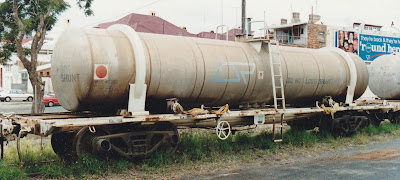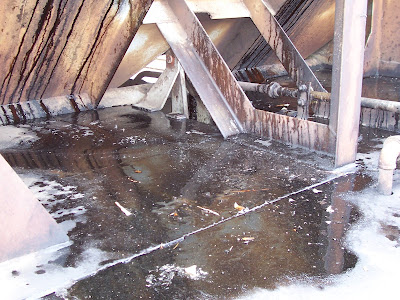200 “BLC” wagons (30942 – 31141) were built by A.E. Goodwin Ltd, in N.S.W. between March 1956 and March 1958. The new wagon was conveyed to Queensland on the NSWR standard gauge network.
The wagons were all steel
construction except the 1⅛” hardwood floor. Body was riveted to the underframe,
roof was fully welded to the bodysides and ends. Steel use in construction,
Pillars & Carlines - 10 G, Side & End (Louvres) – 18 G, Roof lap joined
16 G. In the roof there was 2 layers of 1” thick “Tropal” insulation held into
place with 3/16” bondwood ceiling.
Overall the wagons were 40 ft 6 in long, tare weight of the wagon was 15
tons 10 cwt and they carried 24 tons 10 cwt. Two compartments marked “A” and
“B” over the door were 19ft 9½ in long by 8ft 5in (7ft 6in between door
shields) wide. Battens separating the compartments were 3¾’ x ½’ hardwood. Bogies
fitted to the wagon were QR 2 ride control cast steel type fitted with forged
wheelsets with 9” x 4¼” journals. They had 2’ 9½” spoked wheels with separated
wheel centre and tyre. Drawhooks (D3) with B.K Waughmat rubber cushion
draftgear was fitted to the wagons. New to QR was a screw 15” wheel operated
hand brake. This arrangement was not popular with shunting staff, they were
default to apply, I’m sure it caused many incidents and derailments in yards. The
wagons were painted Dark Admiralty grey.
There is a reference in John Armstrong book “Iron and Steel Wagons of
the Queensland Railways Steam Era” that at first they were painted red oxide
with black underframe for a short time.
Over time, the wagons
were modified and altered. Let’s look at class leader BLC 30942.
|
Date |
Remarks. |
|
8.03.1956 |
In
service. |
|
9.03.1956 |
Damaged
at Roma Street. |
|
15.03.1956 |
Back
to Ipswich Workshops. Headstock repairs, Label holder moved to headstock. Jacking
pads fitted. |
|
Jul
56 |
Derailed
Nundah |
|
Nov
57 |
Derailed
CD |
|
Oct
58 |
Hand
brake modifications. |
|
Aug
59 |
“B”
group springs fitted, side bearers moved to 3’ 1” centres. Stencilled “M”
below Red Diamond – Redbank. |
|
Dec
67 |
Packed
Roller Bearing fitted |
|
Jul
69 |
Fitted
with auto couplings classed BLCT. |
|
Aug
78 |
Partition
modified, 2 Batton removed top & bottom. |
|
Dec
78 |
15”
hand brake wheel replaced with a 17” wheel. |
|
|
Most
wagons had door modification |
|
|
Most
were overhauled and painted ever 2 years. |
|
Nov
86 |
Written
off. |
QR 2 Bogie
By the late 1970’s, smarter
loading methods were being developed. Freight was be packed onto pallets and loaded
by forklift’s, often freight in BLC wagons was covered with traps due to water
entering the wagon at the doors during wet weather, this made QLX wagons a much
better choice. Then, with freight being loaded into containers, the life of the
wagons was in balance. This resulted in any of the class being converted to
other use. Mainly the louvered body was removed.
With the withdrawal of
wooden rollingstock in the mid 1980’s some were allocated to tool/material
wagons attached to camp wagons, others were allocated to breakdown trains.
BLC 30979 written off Oct
88, Donated to Mt Isa Miniature Train Club.
BLC 309832 Heritage.
BLC 30984. Redband
Shunting school.
BLC 31041 Wacol Yard
store wagon. (Oct 84)
BLC 31043 became OB 43939
(Shell Tanker)
Breakdown Wagon.
PCL Wagons.
The first modification
was to single slot container wagons, PCL class. The first wagon was modified in
January 1979 and was classified PCE, a month later that was altered to PCL. CLC
and CMIS wagons (shorter in length, 32 ft) were being similarly treated and
were classified PCE class. Most PCL wagons were written off in the early
1990’s. Some were allocated to Workshops for use as slaves and were classed
DUMP. A few other did find another use. All
up, 61 wagon were converted to the class.
Wagon 30947 was numbered PCE 41322. Due to their length (40ft) carrying
a 20ft load with a low carrying capacity of just 25 tons, the wagon was mainly
used on port transfer duties and lighter class lines. With a floor height of
1035 mm above rail, this also restricted the height of containers they could
carry. Wagons had fixed spigots
and could carry one 20 ft. (6100) or one 25 ft. QRRC or SRC fridge container.
Update 16th April 2024. Additional
Information from Ken Edge-Williams
Here is a photo I took in late 80s of a rake of PCLs in ore traffic from Mungana to Mt Isa
PB Wagons.
30 were converted to carry particle board. These wagons had headboards and the load secured with web straps and covered with a one-piece tarp, they entered service from June 1983.
|
Year |
Numbers
|
|
1983 |
31122,
30956, 31004, 31131, 31120, 31063, 31067, 31085, 30977, 30968 |
|
1984 |
31031,
31032, 31119, 31033, 30989, 31110 |
|
1986 |
30955,
36304, 36305, 36306, 36307, 45362, 45363, 45365, 45366 |
|
1987 |
45364,
45368, 45369, 45370, 45371. |
|
|
|
Monkland
PM Wagons.
Eight (8) were fitted
with ANPA Tanks for molasses traffic, in service from June 1983. 30995 was
classified PTM.
HBC Wagons..
Three (3) wagons were
converted to carry bag cement in 1983. The wagons had head boards and side
gates, the load was covered with a one piece trap (137000 X 51800 mm). The
wagons carried 20 pallets. Numbers - 31102,
36322, 36323
The gates also
had supports like WH/WHE grain wagons.
PST Wagons.
History cards show two
wagons were fitted up to carry locomotive sand to regional deports. (30990
4/84, 30998 3/86). Photos suggest there were others. Some similar sand wagons
were made from CMIS and WHE wagons. Plans and data sheets show the following,
PST 30998 was built for
the Toowoomba depot, 44998 Callemondah depot, 44999 for the Jilalan depot in
1986. 30990 was built for the Pring depot in 1984.
Two additional wagons
were built in 1990 from BLC underframes, Numbers 45788 and 45789.
BSW Wagons.
Five (5) wagons were
modified to carry wheels sets between 1980 and 1994. All up 8 were converted.
31117, 31097, 311124 was
converted from a PCL wagons. Plan P 449
show in 1987 three wagons were built to carry 18 x 915 mm dia. wheelset, Nos
36293, 36299, 36300. Plan P 373 shows 31035 and 31105 were built to carry 19 x
850 mm dia. wheelset. 31124 was
withdrawn from service in 2008 and 31097, 36299, 36300 in 2013. BSW 31103 was
still in service in 2013.
PR Runner.
Seven (7) wagons were
made into runner for long overlength loads. Most were converted 1984 and were
written off in 1993. Wagon 30944 was converted to PRB 44997 in Nov 1985.
TRFA Runners.
1996/7, two (2) wagons
were modified to transfer out of gauge coal hoppers from Ipswich to Central
Queensland. The coal hoppers were raised on their bogies to give clearance in category
1 area (North Coast Line). The TRFA wagons had a coupler at the standard height
on one end, and on the other end a raised coupling for attaching to the raised
coal hopper. 31082 was converted from a PCL wagon. A few years later, a number of BAOY/BAUY
wagons were sent to Redbank Workshop for a later contract of coal hoppers being
manufactured by the workshops for a similar modification. This didn’t come off,
road transporting the wagons was said to be cheaper.???
ORL Tank Wagon.
31130 was fitted with the tank off OB 12 in October 1984 to convey locomotive oil to the Pring deport. Later the wagon was classed ORL/T. The centre part of the tank has a 1850 mm I.D with the ends being 1830 mm I.D. Tank capacity is 22 730 litres.
WSE Water Wagons
Ten water
wagons (45352 – 45361) entered service in 1986 using BLC underframes.
Additional 10 more wagons were built using WHE underframes.
Models:-
I think the first kit of a BLC wagon was produced by “Northern Models”, a Railco project. The kit was a one piece body with an underframe.
The bogies were Steam Era “HO” narrowed
down for 12 mm track and 12 mm axles fitted.
Caintode Flats Products currently
produce a BLC kit. A one piece body with detailing parts, bogies and decals.
A “HBC” wagon was scratched build using
styrene sheet.
Mark out underframe, locations of pivot
bean, centre line, supports etc. before stating on body.
Caintode Flats bogies, buffers and brake
cylinder was used in the construction of the model.
The tarp was made for a JB Hi-Fi plastic shopping bag. The plastic on its own you can see through, a tea bag was painted yellow and used to cover the wagon first before applying the plastic sheet. I wanted a ploy trap look. Some guess work in the tarp markings, now I have found a photo for a fully tarped wagon, well that’s the brakes. Photos has been included above.
Building one wagon, why not build two,
the second BLC cut down is a PCL container wagon.
Not a lot of detail was added, I even forgot to add coupler release levers. Bugger, must be growing old??? The container was screwed to the wagon to keep the floor straight.
The container is a SDS Models QRC container. The website shows all are sold out, could be lucky checking local hobby
shops who stock SDS Models.
The latest issue of the Australian Model Railway Magazine is out in the paper shops. I have two articles published, modelling QR Guards van and a review on SDS/CGL Models 1460/1502 class locomotives. Plus a couple of announcements for QR modellers.
Trust you found the
information helpful for your modelling endeavours, until next time have fun and
enjoy the hobby.
Arthur H.
Acknowledgements.
Australian Model Railway Association
Queensland Library.
QR Plans.
Aurizon Datasheets.
Iron and Steel Wagons of the Queensland
Railways Steam Era” by John Armstrong.
Historians, John Armstrong, Keith
McDonald,
Queensland State Archives











































































































































